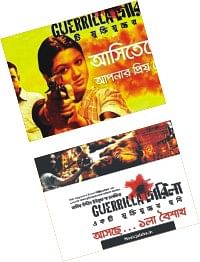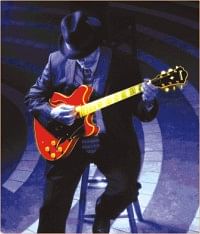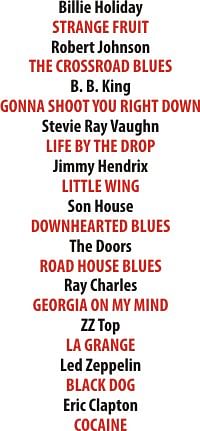 GUERRILLA
GUERRILLA
By Jawad
“Tell me Professor, why do you struggle so much?
What is in independence for you?”
- Colonel Sharfaraz, in an interrogation cell.
The War for Liberation has always been an enigma for all of this generation. What meagre amount of knowledge we have accumulated so far, can't actually convey the feelings of desperation, helplessness, and enormous emotions behind the urge to acquire freedom, tremendous drive to put down lives at all cost to be free of the oppression, to talk in our own language, to make our own decisions and to live free of fear.
 We can seldom understand the anger that blazes through the voices, the sorrow that is reflected in their tones and the pride that gleams in the eyes of our elders, of the ones that fought valiantly to make us a free nation, when they talk about the war. Because we weren't there. Because we haven't fought.
We can seldom understand the anger that blazes through the voices, the sorrow that is reflected in their tones and the pride that gleams in the eyes of our elders, of the ones that fought valiantly to make us a free nation, when they talk about the war. Because we weren't there. Because we haven't fought.
The enormity of the liberation war is quite impossible to depict in a single novel, in a single piece of art or in a full-length film. Because independence wasn't achieved only by the 3 million lives that were put down or by the mass of freedom fighters that fought. Everyone was a fighter. Nasiruddin Yousuff's recent film 'Guerrilla' justifies that claim.
Based on the novel named 'Nisiddho Loban' by Syed Shamsul Haq, the film brings out the lives of those staying behind, remaining as the force that drives the fighters through their efforts economically and sometimes in cases risking their precious lives for the sake of some operations. Their part of the story has nearly always been neglected in the traditional narration where the depictions of the freedom fighters in their actual glory have been preferred. But if it makes you think that, the matchless sacrifices of the fighters have been left out, you will be wrong. They just massed the circumference while the centre was focused on Bilkis Banu who, through her activities in Dhaka and her journey to her village, captures the totality of the war.
The film is one of the best in the history of Bangladesh by dint of the efforts that have been put to shoot it. The 400-year old Panamnagar in Sonargaon was rebuilt into a city without any giant billboards and high-rise apartments to capture Dhaka at '71. And I have to say, their efforts were outstanding, from the paintings on the baby-taxies to the colours of the walls.
The acting was superb. Joya Ahsan looked brilliant in all her scenes. Never for a moment could the audience be sceptical about the character she produced, the enormous sadness she radiated by her waning smile, remembering her happy days and the determination that shrilled through her every action. Ahmed Rubel, ATM Shamsuzzaman and Shotabdi Wadud all were brilliant. The last one deserves special mention for his dual roles as Colonel Sharfaraz and Captain Shamshed. His characterisation was so fantastic and the roles so hateful that the audience positively cheered at their deaths.
Through engaging music, commendable special effects and incredible story telling, the film kept the audience glued to the big screen throughout. It is definitely a film to be remembered for many days to come and to be seen not only in the months of March and December, when our patriotism takes a sudden rise but every time we want to remind ourselves just how proud one must feel to be a Bangladeshi.
 RIO
RIO
By Maofic F. Karin
What if one day, while you are sitting at home relaxing with your marshmallow-floating hot chocolate, you are told that you are one of the last humans on the planet? Well, that's what happened to Blu, a rare blue macaw. In keeping with some other extinct species of birds, he can't fly either [yes, we are looking at you, Dodo].
 Blue macaws hail from the jungles of the Amazon apparently, where Blu was born before he was snatched away by poachers and, by a LotR-like turn of events, found by a little girl in Minnesota. Hence his rather mundane name.
Blue macaws hail from the jungles of the Amazon apparently, where Blu was born before he was snatched away by poachers and, by a LotR-like turn of events, found by a little girl in Minnesota. Hence his rather mundane name.
An ornithologist convinces Blu, and his owner Linda, to travel to Brazil where another female blue macaw, Jewel, resides. It's a repopulating the Earth kind of scenario. Except, Blu and Jewel get kidnapped of course. By a bunch of smugglers and a vengeful cockatoo by the name Nigel.
Rio is a 3D film and it was made by the guys who made Ice Age, so you know what to expect. It is a comedy and adventure film which is exuberant and full of life, just like the city for which it's named after. The dialogues are fun, the soundtrack is excellent and visuals are dazzling.
The voice actors include Jesse Eisenberg [yeah, the guy who played Zuckerberg], Anne Hathaway [she needs no introductions], Jemaine Clement, George Lopez, Jaime Foxx and Will.i.am, who also composed the soundtrack.
Inside its fun outlook, Rio carries a message that protecting the forests is vital to save the environment. The dwindling wildlife is a serious issue, despite the ridicule surrounding the Dodo. Overall, Rio is good, fun movie, to watch with family.
The Blues An Introduction
By Moyukh Mahtab
 Southern trees bear a strange fruit Blood on the leaves and blood on the roots Black bodies swinging on the southern breeze strange fruit hanging from the poplar trees
Southern trees bear a strange fruit Blood on the leaves and blood on the roots Black bodies swinging on the southern breeze strange fruit hanging from the poplar trees
-Billie Holiday
"The blues” is a musical form closely associated with jazz. The term refers to the Blue Devils which means melancholy. As the name implies, the blues was initially slow, sad music with morose lyrics about the struggles and difficulties of the African Americans in the plantations.
It is generally thought to be a form of the jazz but due to the variety of styles, no single one can be pinned as the blues. Neither is it an era in the development of jazz. Originally, music for the lamentations of the then-slaves, blues came to define the most dominant form of music - rock and roll.
The blues came to be due to merge of West African and European music. It was influenced greatly by the field hollers of the plantation workers and spirituals. Field hollers were “shouts” or “cries” with which workers communicated across plantation and this has been described as a “long, loud, musical shout, rising and falling and breaking into falsetto”.
The biggest factor which gives the blues their particular feel are blue tonalities, which is believed to have originated from the West Africans' search for tones, not in the Western European scales.
After the American Civil War, when the African Americans' could perform more openly, the outline of the blues as we see today began to emerge. This usually took on musical measures of 8, 12 or 16 beat, though the twelve beat blues became the most common. It also developed particular chord progressions.
The lyrics, which are a distinctive feature of blues, contain many repetitions of chants of sorrow or a lost soul. They portrayed the extreme sufferings of the down-trodden people. For example, the lines above, from Billie Holiday's 'Strange Fruit', portrays vividly the lynching of the African Americans that raged through the southern states. The blues started to gain popularity with singers like W.C. Handy (called the father of the blues), Bessie Smith, Son House and Billie Holiday.
Another distinctive feature of the blues, the reflection of which can be found in rock and roll, is the fill-ins between verses (guitar solos and so on). While the early blues were just accompanied by guitars, gradually elaborate instrumentation came in to play.
One misconception about the blues is that all the songs are lamentation but though initially the lyrics were just what the name implied - that of sorrow and misery - overtime they came to encompass all forms of emotion from happy to ironic and even to sarcastic.
Blues started to become main stream only after 1917. The likes of B. B. King and Robert Johnson became the pioneers of the blues and made it the most popular music of its time.
Modern rock and roll grew directly out of the blues. The works of the likes of Chuck Berry hold testament to the fact. Jimmy Hendrix, considered the greatest guitarist ever, was a remarkable blues man. Even if rock and roll did not hold on to the traditional blues structure, the influence is easily recognisable.
Guitarists such as Stevie Ray Vaughn were tremendous blues players. Even in works of such iconic bands such as The Doors, ZZ Top and Led Zeppelin, blues elements played a crucial factor. In the guitar solos of David Gilmour, Jimmy Page, Hendrix, and Eric Clapton, the blues elements persist. So unknowingly most of us, in some time or other, have had a taste of the blues.
The blues was once even thought to be the devil's music, believed to cause the “blacks” to act lowly. Along with this, many myths were associated with the blues. The most famous of this is how Robert Johnson sold his soul to the devil to become the king of the delta blues (“Crossroads” movie anyone?)
For people who have never listened to blues, here is a short list of some of the timeless blues pieces- these include both the old and new artists.

References
Wikipedia
Jazz by Tanner, Megill, Gerow
Publicbookshelf.com
